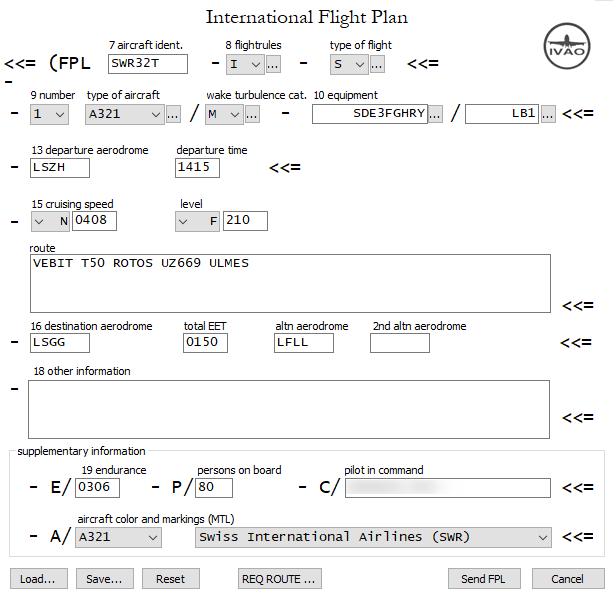How to file a flightplan
Never filled out a flightplan before? No Problem, here you will find all you need to know.

Item 7 – aircraft identification
Item 8 – flightrules
Item 8 – type of flight
Item 9 – number
Item 9 – type of aircraft
Item 9 – wake turbulence category
Item 10 – equipment
Item 10 – equipment
Item 13 – departure aerodrome
Item 13 – departure time in UTC
Item 15 – cruising speed
Item 15 – cruising level
Item 15 – route
Item 16 – destination aerodrome
Item 16 – total EET
Item 16 – alternate aerodrome
Item 18 – other information (only official remarks)
Item 19 – endurance
Item 19 – persons on board
Item 19 – pilot in command
Item 19 – aircraft color and markings (mtl)
7. aircraft identification
One of the following is valid:
8. flightrules
This letter describes the categories of flight rules :
When a “Y” or a “Z” flight is prepared, “VFR” or “IFR” must be entered in the route string wherever the transitions/changes to the flight rules are planned to occur.
8. type of flight
9. number
Number of aircraft if greater than one
9. type of aircraft
ICAO designator according to manufacturer and aircraft model (e.g. A319, C172, etc.)
9. wake turbulence cat.
Assign the correct wake turbulence according to Maximum Take-Off Weight (MTOW). Please note, the wake turbulence does not change in base of current load of aircraft.
10. equipment
Radio Communication , Navigation and Approach Aid equipment.
Preceding the oblique stroke, insert one letter as follows :
and/or one or more of the following letters to indicate the COM/NAV equipment available and serviceable :
10. equipment
Insert one of the following to describe the serviceable SSR equipment carried :
In alternative, based on the latest SSR equipment the following code are available (and usable):
ADS capability requires further explanation of equipment on board and code is put next to SSR equipment code (e.g. LB1, LB2):
13. departure aerodrome
ICAO of the airport from which the flight will start. If no ICAO designator is available, use ZZZZ, and insert name in field 18. with prefix DEP/
13. departure time
Estimated off-block time (time of push-back or taxi out) in UTC (e.g. 0800, 1825)
15. cruising speed
Insert the True Airspeed (TAS) of the flight, or first part of the flight (as requested by authorities):
15. level
Cruising level or altitude in one of the following formats (as requested by authorities):
15. route
Full route followed including change of flight rules if Y or Z, altitude and speed.
IFR-Route example
VEBIT T50 ROTOS UZ669 ULMES
Y-Route example
VEBIT T50 ROTOS VFR Fribourg Lausanne Nyon
Z-Route example
Nyon Lausanne Fribourg IFR ROTOS T50 VEBIT
VFR-Route example
Bremgarten WIL Bern Fribourg Lausanne Nyon
16. destination aerodrome
ICAO of the airport to which the flight will end. If no ICAO designator is available, use ZZZZ, and insert name in field 18. with prefix DEST/
16. total EET
Estimated En-route Time in hours and minutes (e.g. 0050, 0730)
16. altn aerodrome
ICAO of the airport used as alternate. If no ICAO designator is available, use ZZZZ, and insert name in field 18. with prefix ALTN/
18. other information
Insert 0 ( zero ) if no other information, or, any other necessary information in the preferred sequence shown below, in the form of an appropriate indicator followed by an oblique stroke and the information to be recorded.
STS/ATFM EXEMPT APPROVED*
STS/EMER Flights engaged in emergency missions (***)
STS/EXM833 State aircraft, not equipped with 8.33 kHz channel spacing radio equipment prescribed for an area
STS/HEAD Flights with Heads of States*
STS/HOSP Flights with sick or injured persons needing immediate medical assistance, including flights urgently required for life-saving medical care of sick or injured persons. This comprises both flights for the transport of transplants, stored blood and medicine and flights to be conducted to pick up a patient, transplants, stored blood or medicine at the destination place.
STS/HUM Flights operating for humanitarian reasons
STS/NIL Replaces all other STS/entries. Only to be used when reporting flight plan changes.
STS/NONRNAV State aircraft, not equipped with type RNP prescribed for a route segment, a routing and/or an area
STS/NONRVSM State aircraft without RVSM permission.
STS/PROTECTED Flights critical to safety, the flight plan of which is only to be made available to a limited circle of recipients.
STS/RNAVINOP For aircraft, the RNAV equipment of which is inoperable at short notice or no longer complies with the required minimum conditions
STS/SAR Flights engaged in Search and Rescue missions (***)
STS/STATE Government flights
(***) Leads to an automatic exemption from ATFM restrictions.
19. endurance
Total fuel endurance in hours and minutes (e.g. 0145, 0940)
19. persons on board
Insert total people on board of the plane (passengers and crew). If the total number is unknown at the moment of filing, insert TBN (i.e. To Be Notified)
19. pilot in command
Name of the Pilot In Command (PIC)
19. aircraft colour and markings
IVAO
Insert aircraft type you wish other pilots and controllers see you with (when available, if not you can choose similar one), and texture with significant marking.
Real flightplan
Insert the color of the aircraft. This is important for search and rescue-reasons.
Example: White with blue stripes